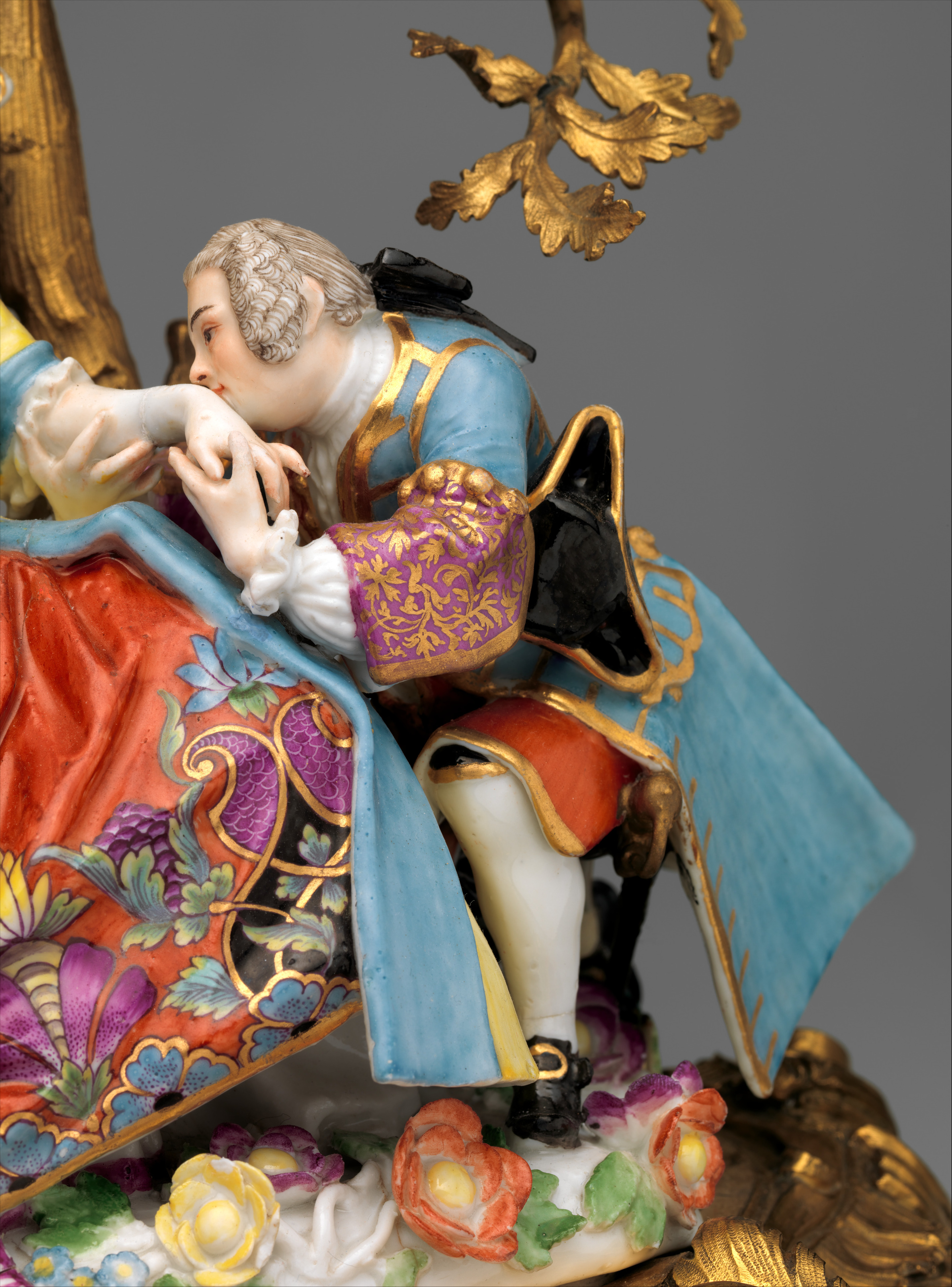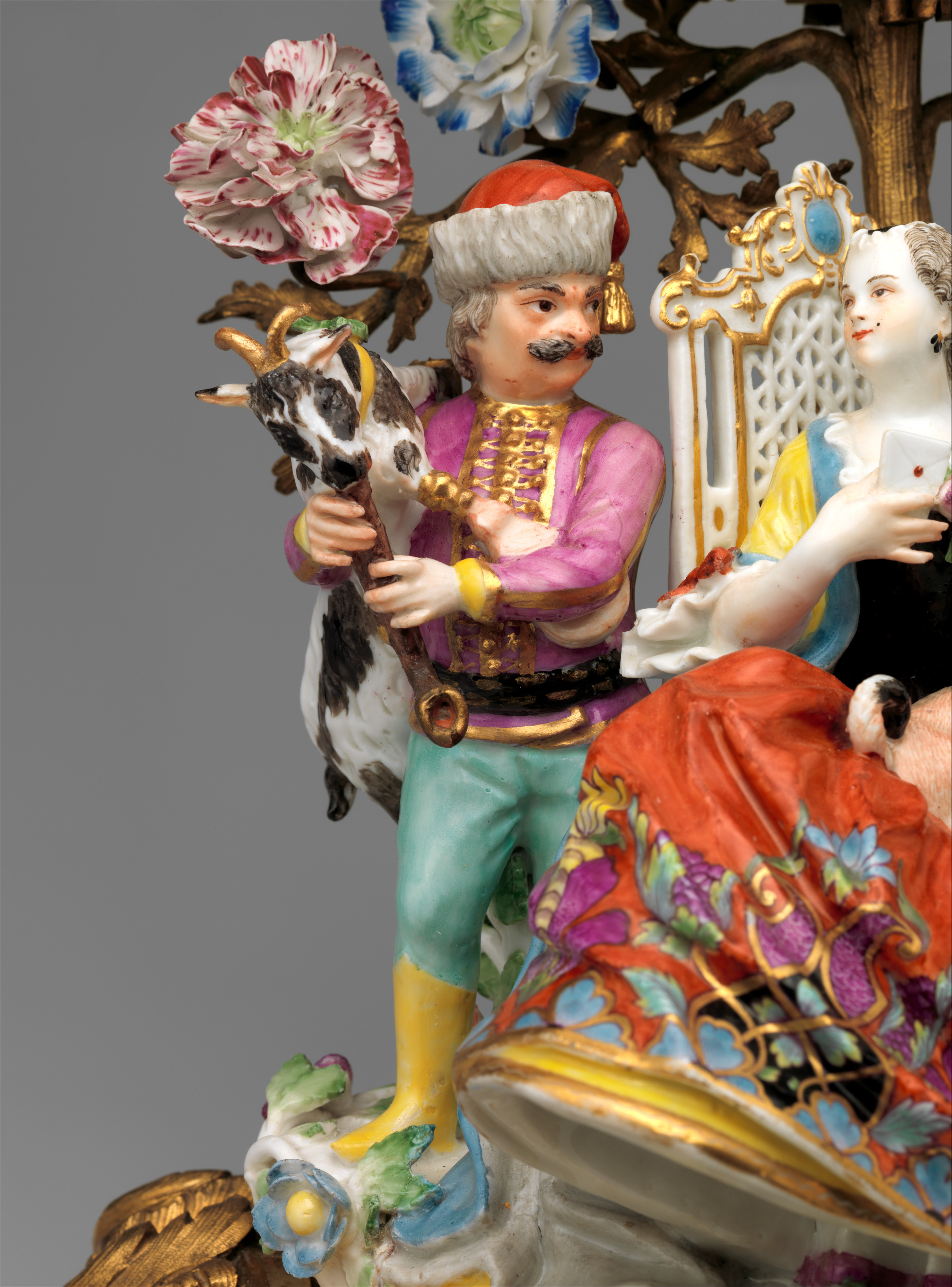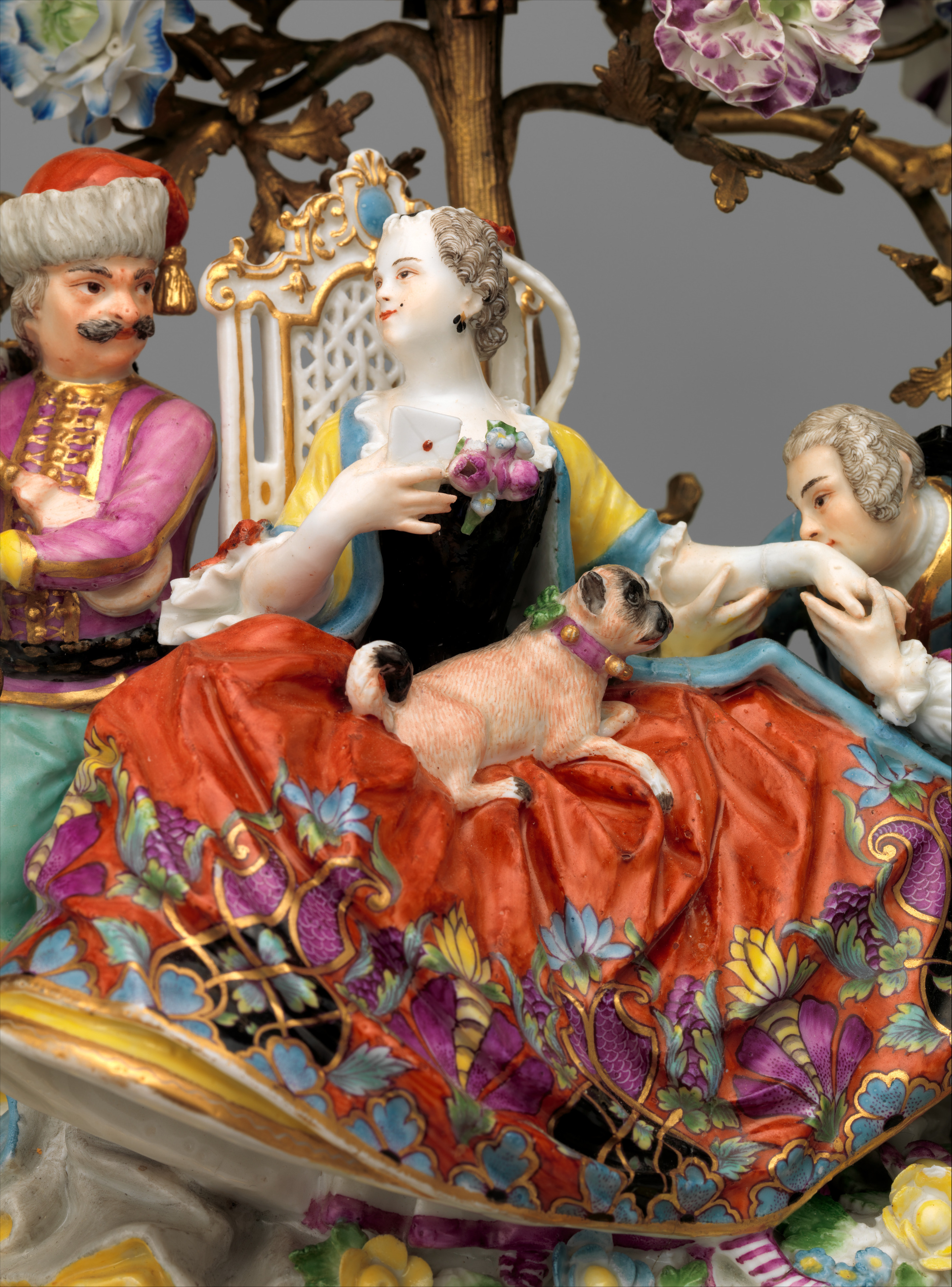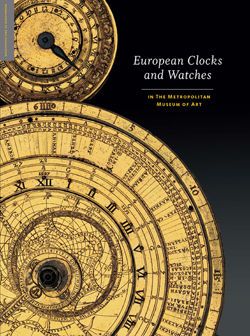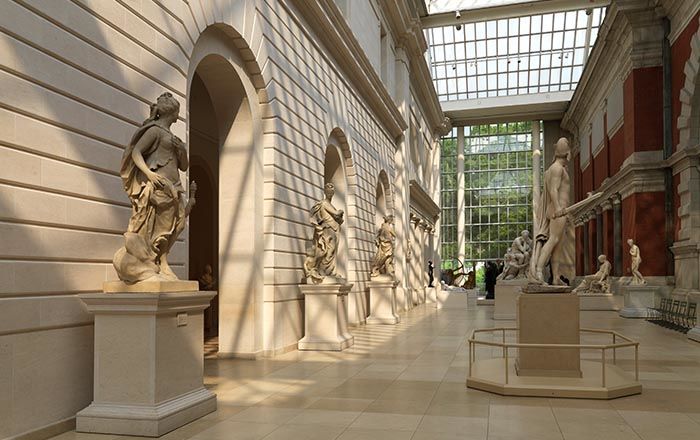Mantel clock (pendule de chiminée)
Clockmaker: Paul Gudin Le Jeune French
Figure group by Meissen Manufactory German
Flowers by Vincennes Manufactory French
Not on view
Eighteenth-century French clockmakers took full advantage of the luxury trades that flourished in Paris as they worked together to provide movements for domestic clocks with splendid cases in various media. This manner of working created difficulty within the community of clockmakers, especially among those who were masters in the clockmakers’ guild. Up until the French Revolution in 1789, guild rules greatly restricted the kinds of cases that could be produced for clock movements. Nonetheless, various solutions had been proposed, including agreements between individual members of other guilds to cooperate with clockmakers; toleration of clockmakers who were not guild masters (a category known as ouvriers libres [free workers]); and the existence of special royal dispensations and privileges for these workers to accommodate the demand for decorative clocks.[1] Probably the most effective solutions, however, were attributed to the activities of members of the Paris corporation of marchands-merciers (merchants of luxury goods). Established in 1407, their corporation was by 1613 permitted to trade in many kinds of merchandise without interference from other corporations or guilds.[2] In the early eighteenth century, Jacques Savary des Brûlons (1657–1716), a former inspector general of French customs, noted that of the six corporations of Paris merchants, the marchands-merciers were considered the most important, regardless of their official ranking as third in line.[3] Further, he listed the twenty divisions within the marchands-merciers corporation, specifically mentioning clocks as belonging to the thirteenth division, which also included paintings, prints, and sculpture.[4] At the time of Savary des Brûlons’s obvservations, the marchands-merciers were known as purveyors of creative designs who combined the products of various skilled craftsmen into a single object.
This clock, with its combination of German hard-paste porcelain figures, French soft-paste porcelain flowers, French gilded-bronze mounts, and French clockwork, is a fine example of the kind of object produced during this period. The movement, housed inside a gilded-brass cylinder supported on the gilded-bronze branch of a flowering shrub, is spring driven. It has a verge escapement and strikes the hours on a bell that is attached by means of a stand screwed to the circular back plate. The back plate also carries the signature: “Gudin le Jeune AParis” (Gudin the Younger), probably that of Paul Gudin (active ca. 1739–55).
The standard biographical dictionary of French clockmakers lists Jacques-Jérôme Gudin l’aîné (Jacques-Jérôme Gudin the Elder; 1732– after 1789) as a master clockmaker in Paris in 1750 and located on the Quai des Orfèvres in 1769–84. It also states that Jacques-Jérôme used the signatures “J. Gudin à Paris,” “Gudin l’aîné à Paris,” and “Gudin à Paris.”[5] More recent research by art historian Jean-Dominique Augarde has established that three members of the family were clockmakers, and, in fact, the widow of the first Gudin carried on his workshop long after his death. Paul Gudin (called Gudin le Jeune; Gudin the Younger), the uncle of Jacques-Jérôme, died about 1755, never having been a master clockmaker.[6] He belonged instead to the class of ouvriers libres and thus apparently not found in the records of the Paris guild. In 1739, Paul Gudin held a royal appointment as Marchand-Horloger Privilégié du Roi suivant la Cour et Conseils de Sa Majesté (Clock-Maker by Appointment to the King following his Court and Councils), [7] which carried with it certain privileges and duties to the royal court. As Augarde has pointed out, the appointment would have allowed Gudin to work undisturbed by complaints from the Paris clockmakers’ guild.[8]
In 1725, Paul’s brother Jacques Gudin (1706–1743) became a master clockmaker in Paris. At the time of his death, records indicate Jacques had an address on the Quai des Orfèvres in Paris, a locale with some of the best clockmakers and where Paul also rented a shop. It is Paul, however, who has been proposed as the maker of movements for clocks and watches for the highly decorative cases in various media, including porcelain, that are signed “Gudin le Jeune.” There is evidence that clocks signed in this manner are for the most part to be found in rococo cases, some bearing the crowned “C” mark on their gilded-bronze mounts (a tax mark used in Paris in 1745–49 for metal alloys containing copper). As Jacques died in 1743 and Jacques- Jérôme did not have his own shop before 1754, Jean-Nérée Ronfort and Augarde reasoned that the signature “Gudin le Jeune” could only have been used by Paul Gudin.[9] One of the more successful marchands-merciers in eighteenth- century Paris was Lazare Duvaux (1709–1758), who held the title of Marchand-Bijoutier Ordinaire du Roy (Merchant Jeweler to the King) in 1748–58. Some of Duvaux’s records have survived, and there is documentation of at least one payment from Gudin of 165 livres for a Meissen porcelain horse with a figure beside it.[10]
The Meissen group found on the Metropolitan Museum’s clock has a complicated history. Commonly known as The Hand Kiss in English, the seated lady wearing a huge crinoline skirt has a pug dog on her lap. A cavalier kneels beside her and kisses her left hand. It has been suggested that these two figures have their origins in a print made by the French painter François Boucher (1703–1770), which also illustrates a scene from the Molière comedy Le Sicilien, ou L’Amour peintre (1667).[11] On the Museum’s clock, however, the attention of the lady is directed to a third figure not found in the painting. This figure on the clock wears the colorful uniform of a Hungarian hussar and carries a remarkably lifelike goatskin bagpipe. As a separate porcelain piece, the third figure is known as Schindler (Court Jester and Hussar), or Schindler the Liebhussar of Count von Bruhl, a reference to the real bodyguard of Count Heinrich von Brühl (1700–1763). Count von Brühl was prime minister to Augustus II (1670–1733), King of Poland, Elector of Saxony, and famously the patron of the porcelain manufactory at Meissen in Saxony. Count von Brühl became head of the Meissen Manufactory in 1733 and then the director in 1739. The meaning of this combination of Schindler with The Hand Kiss is far from certain, but the lady is clearly taken with the hussar, and her attitude prompts the thought that the situation may be closer to one of those found in a Mozart opera than in a Molière play.
Both The Hand Kiss and Schindler are the products of the chief modeler of Meissen, Johann Joachim Kändler (1706– 1775). In April 1737, Kändler reported that his porcelain group depicted a lady with a cup of coffee in her right hand and a man kissing her left. She was also accompanied by an African servant with a salver (64.101.59a, b). By August 1737, this porcelain group had grown, and the lady had now acquired a pug dog, and the African servant was serving coffee.[12] This version of the group seems to have been most popular, and it exists in a number of examples and permutations. Two of the variants appear on other clocks by “Gudin le Jeune.”[13]
The group on the Metropolitan Museum’s clock is mounted on an exuberantly rococo base of partly burnished and partly matte-finished gilded bronze. The base supports the stem of a bush laden with flowers that encircle the dial of the clock. The flowers are from the Vincennes porcelain manufactory (the predecessor to the Sèvres porcelain manufactory established by King Louis XV [1710–1774]), and peeping from the underbrush at the twelve o’clock position of the dial is a porcelain cat of uncertain origin with a dead bird between its front paws. The mounts are unmarked, the Vincennes porcelain was probably made about 1748 or shortly thereafter,[14] and the Meissen porcelain was modeled sometime after about 1737. Gudin is known to have purchased Meissen porcelain as late as 1753, therefore, it is plausible the clock may be dated about 1750 or slightly later.
A tooth that governs the striking of one o’clock on the count wheel is now missing, as is the pendulum. One of the flowers near the head of the cat is a replacement. Otherwise, the clock is in excellent condition.
The clock was in the possession of Maurice Kann, Paris, and also Joseph E. Widener at Lynnewood Hall, Elkins Park, Pennsylvania, before its acquisition by Lesley and Emma Sheafer.[15]
Notes (For key to shortened references see bibliography in Vincent and Leopold, European Clocks and Watches in the Metropolitan Museum of Art. NY: The Metropolitan Museum of Art, 2015)
[1] For an expanded discussion, see Augarde 1996, pp. 13–49.
[2] Sargentson 1998, pp. 99–105. See also Augarde 1996, pp. 179–82, 184, 186.
[3] Savary des Brulons 1761, p. 848. Savary des Brulons’s Dictionnaire universel de commerce was originally published in Paris, beginning in 1723.
[4 Ibid., p. 849.
[5] Tardy 1971–72, vol. 1, p. 279.
[6] Augarde 1996, pp. 329–31.
[7] See Jean-Neree Ronfort and Jean-Dominique Augarde in Wilson et al. 1996, p. 176.
[8] Augarde 1996, p. 36.
[9] Ronfort and Augarde in Wilson et al. 1996, p. 176.
[10] Courajod 1965, vol. 2, p. 162, no. 1443.
[11] Jean-Richard 1978, p. 133, no. 429, ill.
[12] From Kandler’s work reports, quoted in Den Blaauwen 2000, p. 429.
[13] Frühes Meissener Porzellen 1997, pp. 80–81, no. 51; Kjellberg 1997, p. 137, fig. f. See also Sotheby’s 1978, no. 51, ill.
[14] Preaud 2003, p. 51.
[15] See Freeman’s 1944, p. 79, no. 418, ill.
This image cannot be enlarged, viewed at full screen, or downloaded.
This artwork is meant to be viewed from right to left. Scroll left to view more.


